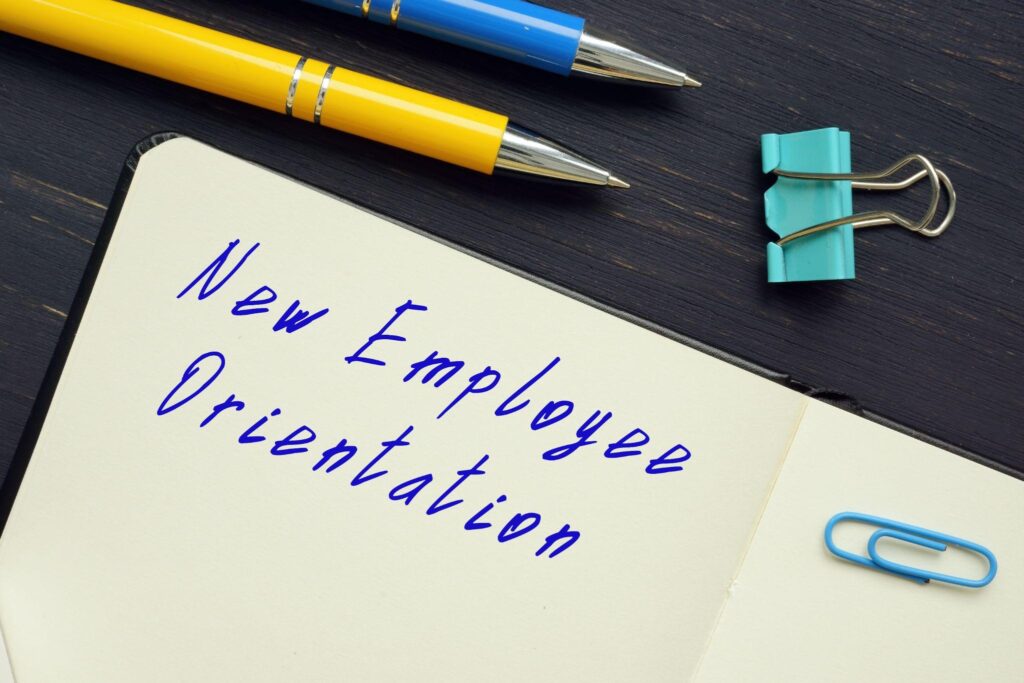First impressions are often lasting.
Think back to your first day on the job. How did you feel? Did you feel supported or kind of lost in the shuffle?
For many new employees, their overall onboarding experience not only helps determine whether they will stay with your company, but it also impacts productivity levels by as much as 50%.
When onboarding your new employee, orientation is one of the most important aspects for small businesses.
New Employee Orientation vs. Onboarding
Often, businesses use the terms “new employee orientation” and “onboarding” interchangeably, but a distinction must be made.
New employee onboarding is the process of introducing your new employees to your organization, their position, and workplace culture. Usually, this process spans from several weeks to a year in length.
On the other hand, new employee orientation is a single event often lasting between one and three days. The goal of orientation is to get your new hire up to speed as quickly as possible.
For small businesses, planning an employee orientation is much different than it is for larger companies.
While bigger businesses often hire dozens of employees at a time, you’ll likely be focused on one or two hires. This gives you the unique opportunity to establish personal connections with new employees, focus on meeting their individual needs, and answer specific questions they have about payroll, benefits, and more.
The New Hire Orientation Process for Small Businesses

As a small business, creating an effective new hire orientation program may seem intimidating, but it’s often easier than you may think.
Here are seven essential new employee orientation steps to include in your process.
1. Introducing employees to your small business
Your first task for welcoming your new employees should always be to introduce them to your company.
Take the time to give them an overview of the company structure, your mission and values, and how their role fits into the bigger picture. This will help your new hires understand your workplace culture and find purpose in the job they’ve been hired to perform.
2. Sharing the logistics with your new hires
It may sound obvious, but orienting employees to the logistics of a business is often overlooked. Here are three things to make sure to cover during your employees’ orientation.
Office Tour
From the minute your new hires step into your office, they have to adapt to a new environment. Conducting a full tour of your office is an easy way to help them feel comfortable and ensure they can get where they need to go without getting lost. If your office is larger or has a more complex layout, you may also want to provide a reference map.
Some common tour stops to include are:
- Restrooms
- Breakrooms
- Water fountains
- Supply closets
- Emergency evacuation routes
- Important locations like first aid kids, fire extinguishers, labor law posters etc.
Workstation Set Up
Once your employee has had a chance to get familiar with the office, you can get them set up with their workstation.
Before your new employee’s first day, try to have their desk set up with the equipment they’ll need and commonly used office supplies. You can also go a step further and include a welcome basket or a simple card letting them know how excited you are to have them on your team.
Payroll Functions
One of the first questions that many new employees have is often “how will I get paid?”
While you may not be completing all the payroll forms just yet, it’s important to explain the payroll basics early on, especially time and attendance tracking. Show your new hires how to use your payroll or timecard system to enter their hours worked, and be prepared to answer questions they may have.
3. Introducing your new employees to the team
Businesses are 4.5 times more likely to keep top talent when there is effective team communication. Once your new employee is settled in, take time to introduce them to the team so they may start building relationships.
On your employee’s first day, allow them to take some time to get to know their team and other co-workers throughout the office. You can do this with desk drop-bys or, if your team has the time, hosting a brief but inviting welcome party.
For remote or virtual teams, you can also accomplish this in a short welcome call with fun icebreakers.
4. Completing new hire paperwork & payroll forms
Often one of the most critical aspects of new employee orientation is making sure your hires complete their required paperwork and payroll forms.
Some common new hire paperwork to complete during this step includes:
- Federal Form I-9 (required) – to verify the employee’s eligibility to work in the U.S.
- IRS W-4 (required) – to withhold federal payroll taxes
- Your State Withholding form (required) – to withhold state and any local payroll taxes
- Direct deposit or pay card paperwork
- New hire reporting notification (required) – for child support collection and other court-ordered garnishments (submitted by a form or electronically)
- Background check forms, if applicable
- Benefit enrollment forms, if applicable
5. Sharing your employee handbook
Your employee handbook is one of the most crucial documents a small business can have. In addition to helping your company comply with employment regulations, it also helps set your new employees up for success.
Before orienting your new hires, take the time to review and improve your employee handbook. Sharing an up-to-date, well-maintained handbook with your new employees during orientation can help them better understand your expectations and your company’s policies.
6. Conducting safety orientation
According to OSHA statistics, new employees are five times more likely than experienced ones to be injured on the job. Injuries among new employees are so common, in fact, that an estimated 1 in 8 workplace injuries happens on the first day of employment.
Although a climate-controlled office environment may seem hazard free, your employees face many risks on a daily basis. From slips, trips, and falls to ergonomic injuries, many of these can be avoided.
To help protect your new employees, it’s crucial to include a safety orientation during your new hire orientation.
Here are some safety basics to cover on your employees’ first day:
- Safety Data Sheets (SDS): OSHA requires that all employers with hazardous chemicals in their workplaces have safety data sheets for their exposed workers. Take the time to show your new employees where relevant SDSs can be found and how to read them.
- Personal Protective Equipment (PPE): If your company provides workers with PPE, ensure your new hires know what’s required, where to obtain it, and how to use it.
- Employee rights and responsibilities: Maintaining a safe workplace is everyone’s responsibility. During orientation, it’s important to cover general safety rules, requirements, and policies. Examples to include are reporting workplace incidents and hazards, filing workers’ compensation claims, and employee rights.
7. Introducing your new hires to their job
Once your new hires are familiar with your company, the office, and their team, you can begin introducing them to their job.
Before their first day, take the time to ensure their job description is up to date and instructions for performing various tasks and job duties are documented. This will help streamline training and ensure your new employees’ are clear on your performance expectations.
New Employee Orientation FAQs for Small Businesses

Does new employee orientation need to be paid?
Generally, yes. According to the Society for Human Resource Management, most of the time, new employee orientation is considered paid work time. This is because it often occurs during regular business hours and is mandatory.
While the Department of Labor does allow exceptions if certain criteria are met, for most small businesses, orientation must be paid.
How long does new employee orientation last?
The length of new hire orientation can vary significantly based on business size and industry.
For small businesses, orientation generally takes between one and two business days. This allows time to complete the standard orientation activities and is often followed immediately by onboarding and new hire training.
Who should conduct new hire orientation for small businesses?
While larger businesses often have a Human Resources team available to conduct a formal orientation presentation, most new hire orientations are conducted by the employees’ direct supervisor. This is especially true for small businesses where orientation is often done on the job in a less formal setting.
If the direct supervisor is unavailable, sometimes orientation can be conducted by a lead worker or training. In these cases, developing a checklist can be especially helpful.
Post-Orientation Next Steps
Conducting an effective new employee orientation is a crucial onboarding step. By making sure your new hires are comfortable in their new environment, complete their payroll and employment paperwork, and are aware of your expectations, you can help set them (and your company) up for success.
After orientation, it’s important to keep that momentum going. Post-orientation, you’ll want to continue to train your new hire and ensure they feel supported in their new role with your company.
With a full range of HR and payroll related products, tools, and true support, CRI Payroll Services can help provide immediate and personalized service to help with many of your Human Resource needs.
Learn how CRI Payroll Services can help support your employees & business.

